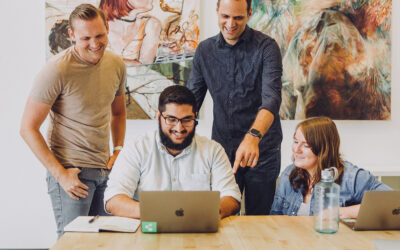It seems the key word over the past few months has been ‘curve’ – we have been doggedly following them hoping for the much anticipated drop in COVID-19 cases low enough that it signalled the return to something close to normal…if that was ever to exist again. We, more locally, particularly in our consulting work, have also been tracking the curve for energy in organisations, which started high – a mix of fear, excitement, worry and camaraderie, and then slowly dipped into more of an accepting state that many of us found ourselves in.
With the consistent lowering of the key COVID-19 metrics, we have seen easing of restrictions and are starting to see glimpses of recovery. This brings with it a whole new conversation – the future of work. Over the past few months a repeating conversation has been the opportunity that the global lockdown, and reboot, offers us in terms of forging a new economy – one that’s more resilient, flexible and purposeful.
In previous weeks, we have been dealing in theory. Whilst much of the world was confined to their homes, and organisations were running in survival mode, we could do little but talk. Things are now changing and although there may be no firm plan for the future of work, each business/institution will now have to go through a series of stages that will help them identify what their future is.
The stages to consider for the future of work
Right now (hopefully) we are emerging out of the first stage – Lockdown is shifting and the work has been done to support people through this tough time. A great deal of effort has been made to grow new skills and connections at this time – building on core technology that supports virtual working and adding a social & community focus that tackles the biggest challenges presented during this time.
Forward focusing organisations are now moving towards, or are already in, the Learning & Planning stage, in preparation for the future of work, however that looks. This is a critical element and should not be underestimated as part of moving forwards. It will provide the elements of ‘the plan’ to move back to near-normality and bring people together in conversations about what these learnings mean for the next phase of the business.
With the move to bring people together physically, there will also be a need to focus on Transition & Reconnection. This will be a balancing act between our collective desire to have a degree of normality (and certainty/security) back in our lives and the boundaries still placed on us by the virus. Asia, which is way ahead of the world in this area, has already been through the ‘day one’ barrier and we’ve seen a great deal of targeted, purposeful activity to help people negotiate a new set of circumstances. The effort is to accelerate a return to sustainability within the organisations, to stabilise people and re-connect them with each other and the wider organisation. In a nutshell, bringing the energy curve back up for our workforce. As a business we’ve put a lot of effort recently into supporting organisations in this area – helping leaders plan their own agenda for return (as well as the wider future of work) and building the framework for teams to connect – starting as simple as tea and cake and building up to organisation-wide reconnections.
The trick will be not to let this stage become the end point, as tempting as it will seem. To create a viable future, most organisations will need to build on the temporary stability of an eased-lockdown state and begin to re-shape to fit both the realities of a protracted pandemic and to grasp the opportunities offered by the radical shifts in working practices that we’ve all adopted in the last few months. This Transformation stage will be the most challenging one, as it requires organisations to step into the unknown and find new ways of delivering their work in a future of work that remains uncertain.
Brave decisions in a new future of work
Already we are seeing companies such as Twitter announce that their employees can choose to work from home forever if they so wish. This is probably the most simple response to the Pandemic that we will see, but it does raise a thousand linked challenges that we all need to negotiate. The world is like an old mattress – press down in one area and the whole thing moves – facilities, transport, hospitality, shops, entertainment (the list goes on) are all impacted if we decide to stay away from cities.
The Transformation stage will be incredibly difficult, as it needs to incorporate both new ways of working and new ‘whys’. Some businesses may not survive because the why, what and how of their business model simply no longer works.
The stark reality of very few people travelling could be the death knell for many airlines – an industry we are already seeing tens of thousands of lay-offs being made. Others will change because they have to for survival and, hopefully, many will change because they can see a better way of delivering what they do. Our purposes (we have many) are already being re-evaluated and the strength of feeling around shifting to a more ethical approach will be one of the major deciding factors in the future of work.
The return of growth as part of the future of work
And there, at the end of a long tunnel is the blazing light of the last stage – Growth. It almost feels like a dirty word at the moment, but it will return. As a species we are incredibly resilient, adaptable and determined – we will hold society together and find a new, positive normal. Getting there is going to take time, and the journey for some organisations will be tough as they have to initially retreat into a slump or contraction phase. Classic change models all point to the ‘chaos’ of the mid-point during change, when the journey to a new future is still long, and the temptation of the old ‘safe harbour’ of how things were is very tempting.
All of these phases will have to overlap if we are to move to a new, positive paradigm. Lockdown will impact us for many months and the transition will be an up and down journey that will frustrate all of us. And transformation is never easy, if it was, more companies would do it successfully. The further along the transformation curve we push, the bigger and more audacious (read also: terrifying) the change becomes. But, sadly, the reverse direction is a shorter, deeper journey of loss.
Within these stages there will be key levers for change that we have to be in control of – ambition, purpose, business models, people, customers – they’ll either be anchors to the past or imperatives for the future. What’s clear, therefore, is every business needs a plan, and the right people, in the right mind-set, to deliver it.
Find out more about how we are helping organisations with the future of work or get in touch to discuss how we could help yours.



